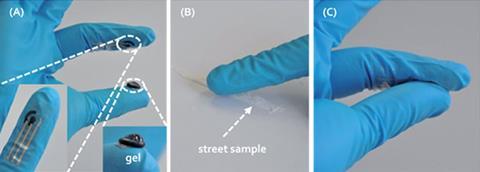Forensic gloves check for cocaine and cutting agents in suspicious powders
An international team of scientists has developed a new glove-based sensor for detecting cocaine quickly and easily. The device could benefit security staff in ports and airports who need on-the-spot results.

The researchers, led by Karolien De Wael at the University of Antwerp in Belgium, and Joseph Wang at the University of California in the US, have expanded the horizons of their forensic finger technology for detecting explosives with their new target: illegal drugs. Their sensor can screen suspicious powders on-site and works for cocaine, as well as cutting agents, including caffeine and paracetamol. The tester wearing the glove touches the sample with their index finger, before rubbing the powder into a gel on their thumb, which connects the circuit and produces the results as an electrochemical signal.
The group tested authentic street cocaine samples provided by the National Institute of Criminalistics and Criminology (NICC) in Belgium that were found to contain between 30–76% cocaine mixed with other white powders such as boric acid and lidocaine.
Traditional cocaine screening methods rely on cobalt thiocyanate-based colour-change tests, which suffer from poor selectivity and require complicated and expensive laboratory techniques such as GC–MS to confirm the results. This new technique has a significantly lower limit of detection than both colour screening tests and the accredited GC–MS technique used by the NICC.












No comments yet